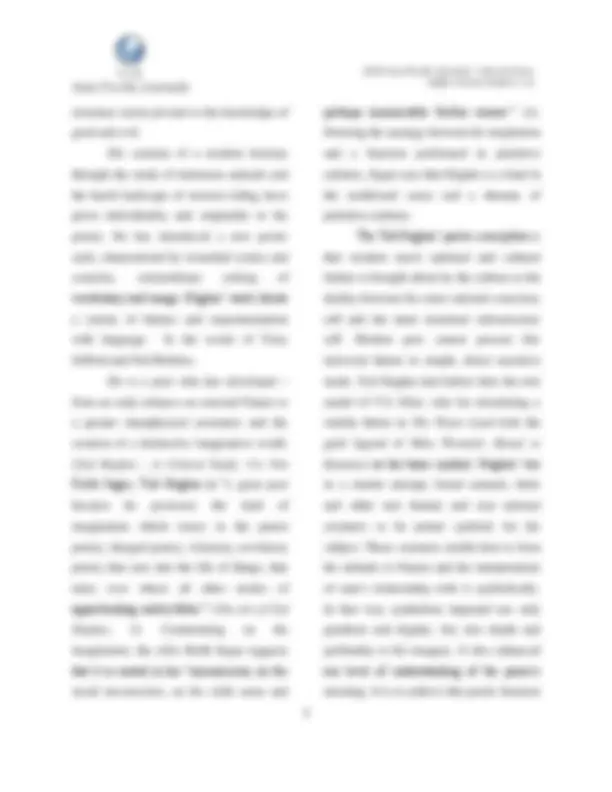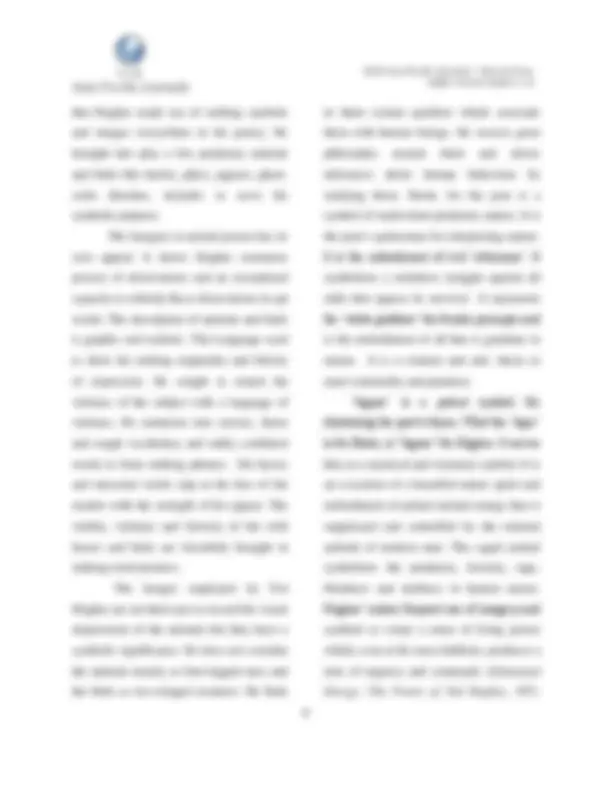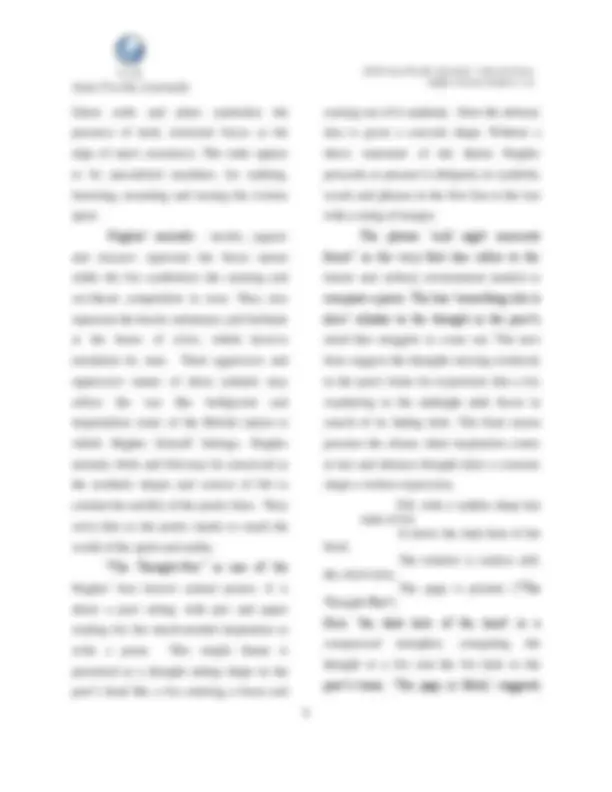





Study with the several resources on Docsity

Earn points by helping other students or get them with a premium plan


Prepare for your exams
Study with the several resources on Docsity

Earn points to download
Earn points by helping other students or get them with a premium plan
Community
Ask the community for help and clear up your study doubts
Discover the best universities in your country according to Docsity users
Free resources
Download our free guides on studying techniques, anxiety management strategies, and thesis advice from Docsity tutors
The symbolism can be an object, person, situation, events or actions that have a deeper meaning in context.
Typology: Slides
1 / 6

This page cannot be seen from the preview
Don't miss anything!




ISBN: 978 - 81 - 930411 - 1 - 6 ‘SYMBOLISM’ IN TED HUGHES’ POETRY Dr. S.B. Radhika Bai. Post Doctoral Fellow Dept. of English. S.V. University, Tirupati. A.P.
‘Symbolism’ is a technique used in literature when some things are not to be taken literally. The symbolism can be an object, person, situation, events or actions that have a deeper meaning in context. Symbolism is often used by writers to enhance their writing and give insight to the reader. Symbolism can give a literary work more richness and colour and can make the meaning of the work deeper. Symbolism can take different forms. Generally, it is an object representing another to give it an entirely different meaning that is much deeper and more significant. Sometimes, however, an action, an event or a word spoken by someone may have a symbolic value. For instance, “smile” is a symbol of friendship. Similarly, the action of someone smiling at you may stand as a symbol of the feeling of affection which that person has for you. Symbolism gives a writer freedom to add double levels of meanings to his work : A literal one that is self-evident and the symbolic one whose meaning is far more
profound than the literal one. The symbolism, therefore, gives universality to the characters and the themes of a piece of literature. Symbolism in literature evokes interest in readers as they find an opportunity to get an insight of the writer’s mind on how he views the world and how he thinks of common objects and actions, having broader implications. In symbolism, ideas are presented obliquely through a variety of symbols. The poet awakes, in the readers, a response or a reaction beyond the levels of ordinary consciousness. The Symbolist poets are convinced that the transient objective world is not a true reality but a reflection of the invisible absolute. It is on this account that they defied realism and naturalism, which are aimed at capturing the transient. They do not define or describe emotions or ideas directly through explicit metaphors and similes but by suggesting implicitly. Images and symbols used through metaphors, similes, personification, hyperboles and other figures
ISBN: 978 - 81 - 930411 - 1 - 6
of speech are potent tools in the hands of a poet to convey his meaning and message.
Edward James "Ted" Hughes, ( August 1930 – 28 October 1998) was an English poet and children's writer. Critics routinely rank him as one of the best poets of his generation. Hughes was British Poet Laureate from 1984 until his death. Hughes was married to American poet Sylvia Plath, from 1956 until her suicide in 1963 at the age of 30. His part in the relationship became controversial to some feminists and (particularly) American admirers of Plath. His last poetic work, Birthday Letters (1998), explored their complex relationship. These poems make reference to Plath's suicide, but none of them addresses directly the circumstances of her death. A poem discovered in October 2010, Last letter , describes what happened during the three days leading up to Plath's suicide. In 2008 The Times ranked Hughes fourth on their list of “The 50 greatest British writers since 1945 ”. Ted Hughes, a poet laureate is called a ‘Zoo laureate,’ ‘an animal poet,’ ‘a poet of blood and guts,’ ‘a terror’s ambassador,’ ‘a Heath cliff,’ and ‘an incredible hulk of
British literature.’ The same poet's poetry is termed ‘a dismaying badness,’ ‘a raw-sex- violence imagery.’ All this is in bitter condemnation which is evident from his uncompromising, obsessive preoccupation with beasts, birds, plants, insects, landscapes and other wild living- beings in the natural world, which finds a permanent place in all his voluminous anthologies of poems. Hughes’s lengthy career included over a dozen books of poetry, translations, non-fiction and children’s books, such as the famous The Iron Man (1968). His books of poems include: Wolfwatching (1990), Flowers and Insects (1986), Selected Poems 1957 – 1981 (1982), Moortown (1980), Cave Birds (1979), Crow (1971), and Lupercal (1960). His final collection, The Birthday Letters (1998), published the year of his death, documented his relationship with Sylvia Plath. Hughes’s work is marked by a mythical framework, using the lyric and dramatic monologue to illustrate the intense subject matter. Animals appear frequently throughout his work as deity, metaphor, persona, and an icon. Perhaps the most famous of his subjects is “Crow," an amalgam of god, bird and man, whose
ISBN: 978 - 81 - 930411 - 1 - 6
that Hughes made use of striking symbols and images everywhere in his poetry. He brought into play a few predatory animals and birds like hawks, pikes, jaguars, ghost- crabs thrushes, skylarks to serve his symbolic purpose. The Imagery in animal poems has its own appeal. It shows Hughes enormous powers of observations and an exceptional capacity to embody these observations in apt words. The description of animals and birds is graphic and realistic. The Language used to show his striking originality and felicity of expression. He sought to match the violence of the subject with a language of violence. He summons into service, dense and rough vocabulary and oddly combined words to form striking phrases. His heavy and muscular words slap at the face of the readers with the strength of his jaguar. The vitality, violence and ferocity of the wild beasts and birds are forcefully brought in striking word pictures. The Images employed by Ted Hughes are not there just to record his visual impressions of the animals but they have a symbolic significance. He does not consider the animals merely as four-legged ones and the birds as two-winged creatures. He finds
in them certain qualities which associate them with human beings. He weaves great philosophy around them and draws inferences about human behaviour by studying them. Hawk, for the poet is a symbol of malevolent predatory nature. It is the poet's spokesman for interpreting nature. It is the embodiment of evil ‘otherness’. It symbolizes a relentless struggle against all odds that oppose its survival. It represents the ‘white goddess’ the female principle and is the embodiment of all that is grandeur in nature. It is a contrast and anti- thesis to man's rationality and puniness. ‘Jaguar’ is a potent symbol for illustrating the poet's theme. What the ‘tiger’ is for Blake, is ‘Jaguar’ for Hughes. It serves him as a mystical and visionary symbol. It is an evocation of a beautiful nature spirit and embodiment of primal animal energy that is suppressed and controlled by the rational attitude of modern man. The caged animal symbolizes the predatory, ferocity, rage, blindness and deafness in human nature. Hughes’ makes frequent use of imagery and symbols to create a sense of living power which, even at his most nihilistic, produces a note of urgency and command. ( Elemental Energy: The Poetry of Ted Hughes , 107).
ISBN: 978 - 81 - 930411 - 1 - 6
Ghost crabs and pikes symbolize the presence of dark, irrational forces at the edge of man's awareness. The crabs appear to be specialized machines for stalking, fastening, mounting and tearing the victims apart. Hughes’ animals - hawks, jaguars and macaws represent the fierce nature while the fox symbolizes the cunning and cut-throat competition in men. They also represent the heroic endurance and fortitude at the hours of crisis, which deserve emulation by men. Their aggressive and oppressive nature of these animals may reflect the war like belligerent and imperialistic traits of the British nation to which Hughes himself belongs. Hughes animals, birds and fish may be conceived as the aesthetic shapes and sources of life to combat the sterility of the poetic lines. They serve him as the poetic masks to reach the world of the spirit and reality. “The Thought-Fox” is one of the Hughes' best known animal poems. It is about a poet sitting with pen and paper waiting for the much-needed inspiration to write a poem. This simple theme is presented as a thought taking shape in the poet’s head like a fox entering a forest and
coming out of it suddenly. Here the abstract idea is given a concrete shape. Without a direct statement of the theme Hughes proceeds to present it obliquely in symbolic words and phrases in the first line to the last with a string of images. The phrase ‘mid night moments forest’ in the very first line refers to the lonely and solitary environment needed to compose a poem. The line ‘something else is alive’ alludes to the thought in the poet’s mind that struggles to come out. The next lines suggest the thoughts moving restlessly in the poet's brain for expression like a fox wandering in the midnight dark forest in search of its hiding hole. The final stanza presents the climax when inspiration comes at last and abstract thought takes a concrete shape a written expression, Till, with a sudden sharp hot stink of fox It enters the dark hole of the head. The window is starless still; the clock ticks, The page is printed. (‘The Thought-Fox’). Here ‘the dark hole of the head’ is a compressed metaphor, comparing the thought to a fox and the fox hole to the poet’s brain. ‘The page is filled,’ suggests